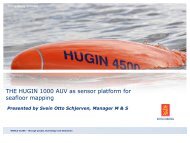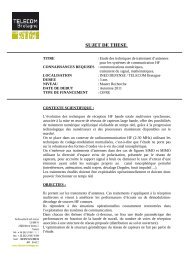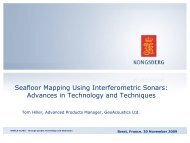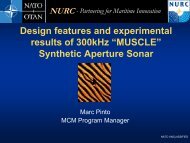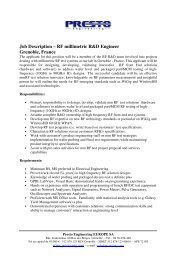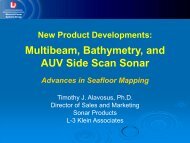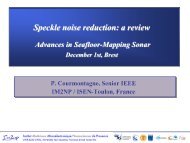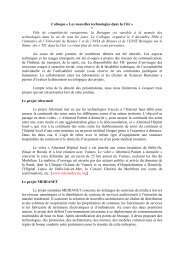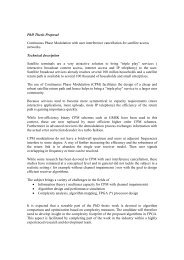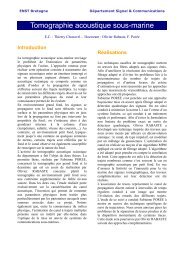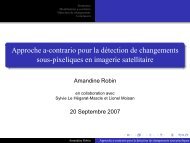Département Réseau, Sécurité et Multimédia Rapport d'Activités 2008
Département Réseau, Sécurité et Multimédia Rapport d'Activités 2008
Département Réseau, Sécurité et Multimédia Rapport d'Activités 2008
You also want an ePaper? Increase the reach of your titles
YUMPU automatically turns print PDFs into web optimized ePapers that Google loves.
Wireless Mesh N<strong>et</strong>worksResearch Staff : S. Houcke, Nicolas Montavont, Yvon Le Roux, Fabien Nicolas, Jacky Ménard, JeanpierreJoliv<strong>et</strong>, Claude Toquin.Phd Students: Bui Quoc Anh, Safaa Hachana.Keywords : Mesh, Ad-Hoc, WIMAX, routing.Applications : Wireless CommunicationsPartners and Funding : Pôle de compétitivité mer, with Alcatel, Thomson GrassValley, MorganConseil, C2 Innovativ System, IFREMER, Aker Yards, TELECOM Br<strong>et</strong>agneIntroductionWireless Mesh N<strong>et</strong>work (WMN) is a promisingwireless technology for several emerging andcommercially interesting applications. It isgaining significant attention as a possible wayfor Intern<strong>et</strong> service providers and other endusersto establish robust and reliable wirelessbroadband service access at a reasonnablecost. Different from traditional wirelessn<strong>et</strong>works, WMN is dynamically self-organizedand self-configurable. In other words, thenodes in a mesh n<strong>et</strong>work automaticallyestablish and maintain n<strong>et</strong>work connectivity.Ex-trem projectThe goal of the project is to give to the boatsthe continuity of communication services overthe sea. First of all, the effort is focused to theharbour area and the area close to the coast.Indeed the main requests are coming fromthose areas. The system is based on WiMAXtechnology. This project is linked to the « pôlede compétitivité Mer » with Alcatel, ThomsonGrassValley, Morgan Conseil, C2 InnovativSystem, IFREMER, Aker Yards, TELECOMBr<strong>et</strong>agne. The project is planned from 01/2007to 01/2010. The project is made of two stagesas explained below.The first phase lasts from March 2007 toSeptember 2007 and was dedicated to thestudy of what is already deployed in boatcompanies. This phase was very useful as wediscovered that many services are alreadyavailable, but they usually do not use IP. Inaddition, we gathered the demand for newservices in these companies.The second phase started in September 2007and is dedicated to the definition of newservices. The project is especially interestedinto the WiMAX technology, because it wouldallow covering larger areas at higher bit rat<strong>et</strong>han the Wifi technology. Therefore, animportant effort in the project is dedicated tostudy WiMAX transmission over the sea, tostudy how it can be improved, and to providean architecture for its deployment. The actionof TELECOM Br<strong>et</strong>agne in this project is splitinto 3 tasks.The Signal & Communication department willstudy the mesh capability with WiMAX. Indeed,although the range of WiMAX is much higherthan with Wi-Fi, it will not be enough to coverlarge sea areas. Each boat having theproposed system acts as a node and is a relayfor ships out of range of the Earth Basedstation. This will allow us to increase thecover of the proposed services. In order tominimize the overhead communication fors<strong>et</strong>ting-up the n<strong>et</strong>work, we will developapproaches based on Ad-hoc n<strong>et</strong>works and tryto g<strong>et</strong> an adaptative n<strong>et</strong>work. Our first task isto propose a multiple access technique whereall the users will have the same code, sameinterleaver <strong>et</strong>c... the separation of the users isdone by the unsynchronization of the differentusers [1]. This approach is based onInterleaved Division Multiple Access initialyproposed by L. Ping in 2002. The mainadvantage is that we won't need to allocateany spreading code to the different users.The second task of TELECOM Br<strong>et</strong>agne is thestudy of complementarity of h<strong>et</strong>erogeneousn<strong>et</strong>works for services support and theadaptation of the quality of the service inaccordance with the n<strong>et</strong>work capacity. Thiswork is conducted in the RSM department. Itwill contribute to the mesh n<strong>et</strong>work workconducted by the department of Signal &Communication by providing an automatic anddynamic routing protocol for boats. In order todo so, we are studying the state of the art ofthe mesh and ad-hoc routing protocols topropose an adequate solution that fits ourcase. Indeed, several techniques have alreadybeen defined for neighbor discovery, addressauto-configuration and dynamic routing in66 Pracom’s Annual Report <strong>2008</strong>



